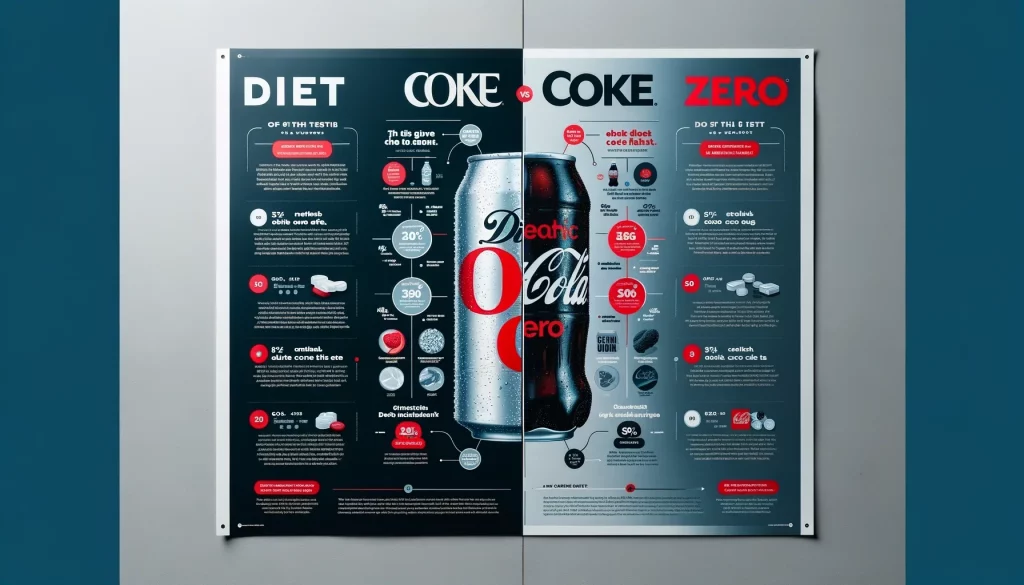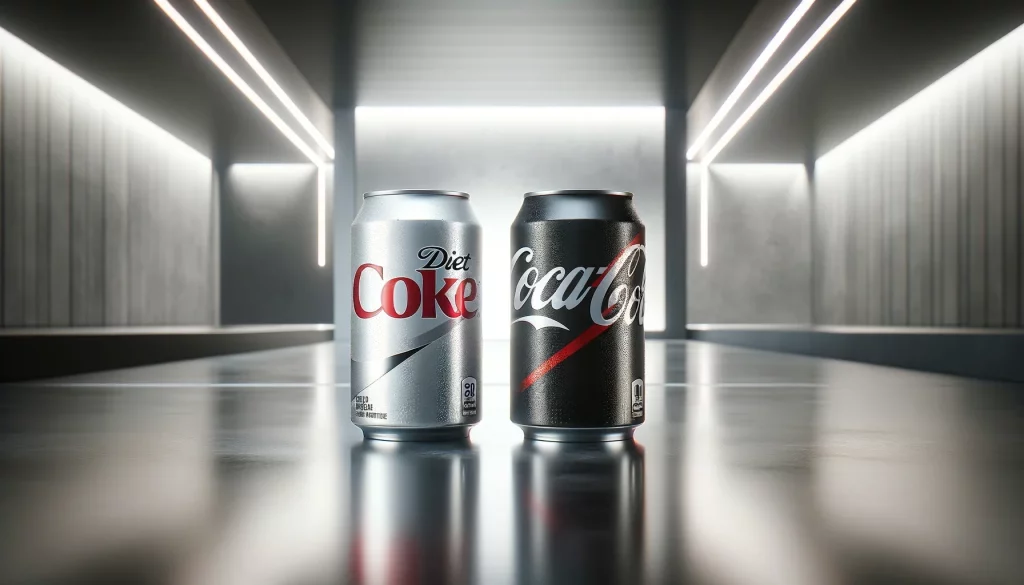|
Getting your Trinity Audio player ready...
|

Introduction to Diet Coke and Coke Zero
Diet Coke and Coke Zero are two popular no-calorie cola beverages produced by The Coca-Cola Company. Both drinks offer a calorie-free alternative to classic Coca-Cola but with distinct flavors and target markets.
Understanding Artificial Sweeteners
Both Diet Coke and Coke Zero use artificial sweeteners instead of sugar. Diet Coke was originally sweetened with aspartame and saccharin, though modern formulations primarily use aspartame. Coke Zero, on the other hand, uses a combination of aspartame and acesulfame potassium for sweetening.
Historical Evolution
The Birth of Diet Coke
Diet Coke was introduced in 1982 as a response to the growing demand for a low-calorie alternative to Coca-Cola. This project, which had been considered for two decades, became a reality as The Coca-Cola Company sought to introduce a product that maintained the taste of Coca-Cola without the sugar and calories.
The Introduction of Coke Zero
Coke Zero was introduced in 2005 as Coca-Cola’s largest product launch in 22 years. It was developed to appeal to a broader audience, particularly men who perceived Diet Coke as a female-oriented drink. Coke Zero was marketed to taste more like standard Coca-Cola compared to Diet Coke.
Ingredient Analysis
Key Ingredients in Diet Coke
Diet Coke’s key ingredients include carbonated water, caramel color, aspartame, phosphoric acid, potassium benzoate, natural flavors, and caffeine.
Key Ingredients in Coke Zero
Coke Zero contains similar ingredients, such as carbonated water, caramel color, and caffeine. However, it includes potassium citrate and acesulfame potassium, differentiating it from Diet Coke.
Comparative Ingredient Analysis
While both drinks share several common ingredients, the inclusion of potassium citrate and acesulfame potassium in Coke Zero and citric acid in Diet Coke contributes to their distinct taste profiles.
Flavor Profile
Tasting Notes: Diet Coke
Diet Coke has a lighter taste compared to classic Coca-Cola, with a different flavor profile that some describe as crisper and sharper.
Tasting Notes: Coke Zero
Coke Zero was designed to mimic the taste of standard Coca-Cola closely. Its flavor is often described as smoother and more akin to the original Coca-Cola compared to Diet Coke.
Flavor Comparison
The primary difference in flavor between the two lies in Coke Zero’s closer resemblance to the original Coca-Cola flavor, while Diet Coke has a unique taste that distinguishes it from the classic Coca-Cola.

Nutritional Information
Diet Coke Nutritional Facts
Diet Coke contains zero calories and sugar, positioning it as a low-calorie alternative to traditional sodas.
Coke Zero Nutritional Facts
Coke Zero also offers zero calories and sugar, similar to Diet Coke, with slight variations in the formula to achieve a taste closer to classic Coca-Cola.
Health Implications
The health implications of consuming any diet soda, including Diet Coke and Coke Zero, should be considered in the context of one’s overall diet and lifestyle. While these drinks are low in calories, moderation is key, and they should not be viewed as health drinks.
Diet Coke’s Market Strategy and Coke Zero’s Brand Image:
- Diet Coke was launched as a distinct product from Coca-Cola, targeted at health-conscious individuals and people with diabetes. It initially used skimming pricing and later switched to competitive pricing. Diet Coke has a wide distribution network, making it easily available at various retail outlets. Various versions like Diet Coke with Splenda, Lime, and Cherry have been launched over the years.
- Coke Zero, rebranded as Coca-Cola Zero Sugar, was introduced in 2005 as a calorie and sugar-free option with original Coke taste. The brand is part of Coca-Cola’s shift towards a “Total Beverage Company” under a “One Brand” strategy. The rebranding emphasizes the zero sugar content to appeal to consumers seeking healthier options.
Consumer Perceptions and Demographics:
- Diet Coke has traditionally targeted female consumers, with marketing efforts directed heavily towards this demographic. However, it has seen less success among men, likely due to the connotation of “diet” sodas.
- Coke Zero has achieved higher market penetration among men, possibly because it avoids the “diet” label and is perceived as having a stronger, bolder flavor. Its packaging shifted from white to black cans to appeal more to male consumers.
Advertising Campaigns and Media Influence:
- Diet Coke’s “You Do You” campaign aimed to tap into mainstream culture, using colloquial language and relatable scenarios. It featured TV ads, limited-edition packaging with popular expressions, and an integrated marketing approach.
- Coke Zero’s notable campaign, “You Don’t Know Zero ‘Til You’ve Tried it,” was innovative, offering drinkable ads in various media, including TV, magazines, and billboards. This campaign emphasized the experience of the product’s taste.
Scientific Studies and Health Debates:
- There are various health concerns and debates surrounding diet sodas. Studies have shown mixed results, with some indicating potential health risks like a higher chance of diabetes and heart issues, while others suggest diet sodas might be a better alternative to sugary drinks. The concerns often revolve around artificial sweeteners like aspartame.
Incomplete Areas:
- The environmental impact and sustainability section, including the production process, packaging, recycling efforts, and carbon footprint comparison for Diet Coke and Coke Zero, was not covered.
- The cultural influence of both beverages, including their presence in popular culture and celebrity endorsements, was not explored due to time constraints.
Global Availability and Variations
Distribution of Diet Coke
- Global Presence: Diet Coke, also known as Coca-Cola Light or Coca-Cola Diet, is distributed globally by the Coca-Cola Company. It was the first new brand to use the Coca-Cola trademark since its inception in 1886.
- Regional Variants and Flavors: The sweetener blend in Diet Coke varies by country based on consumer preference. In some countries, it’s sweetened with a blend containing aspartame, cyclamates, and acesulfame potassium [10†source]. Various flavors like Diet Cherry Coke, Diet Vanilla Coke, and others have been introduced in different regions.
Distribution of Coke Zero
- Global Presence: Coke Zero is available in countries like New Zealand, Australia, the United States, the Middle East, and most Asian countries including India and Afghanistan. Coca-Cola uses its own trucks for distribution to various outlets like corner shops, supermarkets, and fast food outlets.
- Regional Variants: Coke Zero is available in several flavored variations. In different countries, it has been introduced with various names, such as Coca-Cola Zero sans caffeine in France, Coca-Cola Zero Free in Japan, and Coca-Cola Zero Caffeine Free in the Netherlands.
Legal Battles and Regulations
Lawsuits Involving Diet Coke
- Class Action Lawsuit: Coca-Cola faced a lawsuit alleging that the use of the name “Diet Coke” is misleading. Plaintiffs claimed that aspartame in Diet Coke might lead to weight gain and associated health issues. Coca-Cola argued that the term “diet” is permissible for zero-calorie products.
Legal Challenges for Coke Zero
- Trademark Battle: Coca-Cola has faced challenges in trademarking the term “zero.” Regulators in Canada and the UK have rejected their trademark applications. Competitors argue that “zero” generically refers to calorie-free sodas. The outcome of these efforts could impact Coca-Cola’s exclusive rights over the term in the beverage market.
Diet Coke and Coke Zero in Social Media
Online Presence and Digital Marketing
- Facebook: Coca-Cola’s main Facebook page has 93 million fans. Diet Coke and Coca-Cola Zero also have dedicated pages with 2.5 million and 6.8 million fans, respectively. The engagement levels are relatively low compared to other brands.
- Twitter: Coca-Cola’s main Twitter feed has 3.11 million followers and has tweeted 143 thousand times. The company primarily uses Twitter to respond to @mentions. The Diet Coke page is more focused on marketing messages.
User Reviews and Testimonials
Real User Experiences: Diet Coke
- Reviews vary widely, with some users loving the taste and refreshing quality, while others criticize it for its artificial sweeteners and associated health concerns. Some prefer it over regular Coke, while others find it lacking in taste
Future Trends and Predictions
Innovations in the Diet Soda Market
- Market Growth: The low- and no-calorie soda market generated $20.99 billion in 2022 and is expected to grow to $26.67 billion by 2033, with a CAGR of 2.2%.
- Health Concerns: Increasing health concerns are driving the demand for healthier beverages over sugary ones. The market initially targeted diabetic patients but now also focuses on the rising obese population.
- New Product Launches: Companies are employing strategies like new product launches, innovative campaigns, and appealing packaging.
- Sugar Tax Benefit: These sodas benefit from being exempt from sugar taxes, which can drive consumers from regular sodas to low-calorie versions.
- Competition from Natural Drinks: The growing popularity of vegetable and natural fruit juices, along with freshly prepared juices and smoothies, might challenge the low-calorie soda market.
- Developing Markets: There’s increasing acceptance in developing regions with a substantial young population, focusing on new tastes and flavors.
- Sustainable Packaging: Innovations in packaging to use sustainable materials are attracting environmentally conscious consumers.
- Healthy Soda Alternatives: The rise of healthy sodas like seltzers, sparkling waters, and club sodas is notable, as they cater to the demand for zero or low-calorie beverages.
Predicted Trends for Diet Coke and Coke Zero
- Coca-Cola Zero Sugar: Reformulated in 2021 to more closely mirror the taste of traditional Coca-Cola. It’s a zero-calorie and sugar alternative.
- Competitors’ Moves: PepsiCo Inc. launched an improved version of Pepsi Zero Sugar in 2023, emphasizing the innovation in flavor profiles
Conclusion: Distinguishing Diet Coke from Coke Zero
In conclusion, while both Diet Coke and Coke Zero are flagship products of the Coca-Cola Company, designed to cater to health-conscious consumers seeking low-calorie soda options, their differences are quite pronounced. Diet Coke, a longstanding favorite, offers a unique flavor profile that has its own loyal following. It represents a lighter version of the classic Coca-Cola taste, appealing to those who favor a lighter and distinct taste. On the other hand, Coke Zero, with its closer mimicry of the traditional Coca-Cola flavor, targets those who desire the classic taste without the calories.
The key distinctions lie in their ingredient compositions, flavor profiles, and targeted consumer demographics. Diet Coke uses a slightly different blend of flavors and sweeteners compared to Coke Zero, leading to a unique taste experience. Nutritionally, they are similar, yet some subtle differences in their formulas cater to different taste preferences and dietary requirements.
Both beverages have made significant impacts in the world of soft drinks, each carving out its own niche. Their global reach, cultural significance, and the passionate debates they spark among soda enthusiasts are a testament to their enduring popularity.
- Is Chobani Healthy? Benefits and Comparisons - April 22, 2024
- Fatty15 Supplement Review – Benefits, Safety, and User Insights - March 22, 2024
- Dime Beauty Reviews – Honest Insights for Radiant Skin - March 20, 2024
